
This is the abstract for a talk I’ll be giving in Mannheim, at a conference entitled “Networks in American Culture/America as Network” (16-17 March 2012):
Networks of Mediation: Serial Figures as Mediators of Change
Shane Denson
Series, in a wide range of forms, constitute not only the “contents” of various media (television, film, literature, etc.), but might also might be conceived as media in their own right—though in a somewhat unorthodox, non-apparatic sense of the word. Here “medium” is related to “milieu”: environment for expression, articulation, action, or agency. Conceiving media this way means seeing them not simply as channels for communication between pre-existing agencies, but as co-constitutive of the agential potentials that can be realized in a given environment; in Bruno Latour’s terms, media and media-technologies are not mere “intermediaries” but active “mediators” that themselves enable distinctions between subjects and objects and thus play a radically non-neutral role in constructing networks of communication and interaction. Clearly, narrative television series, as one example, can be said to constitute the milieux in which their characters live and act; but to position series as media in a strong sense is to suggest a perspectival inversion of form/content relations, i.e. to see the framing medium of the televisual, filmic, or other apparatus as, in a sense, framed (or re-framed) by the series conventionally taken as that medium’s content. This reversal, I contend, is not arbitrary, but instead effected from within series themselves; the agents behind such inversions are those serially instantiated figures (e.g. Frankenstein, Tarzan, Batman, or Dracula) that populate series and move between a range of media, thus serving as loci for the proliferation of plurimedial networks. Such figures lead a double existence, at once anchored in the linear chains of ongoing monomedial series and also living in the interstices between (apparatic) media, forging decentralized or distributed nets or meshes among them. And particularly the interchange between linear and non-linear serial forms sheds light on transformations in the apparatic and discursive media that carry (and are carried by) series as mediators of media networks.
0 thoughts on “Networks of Mediation”